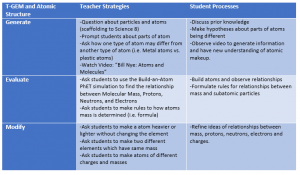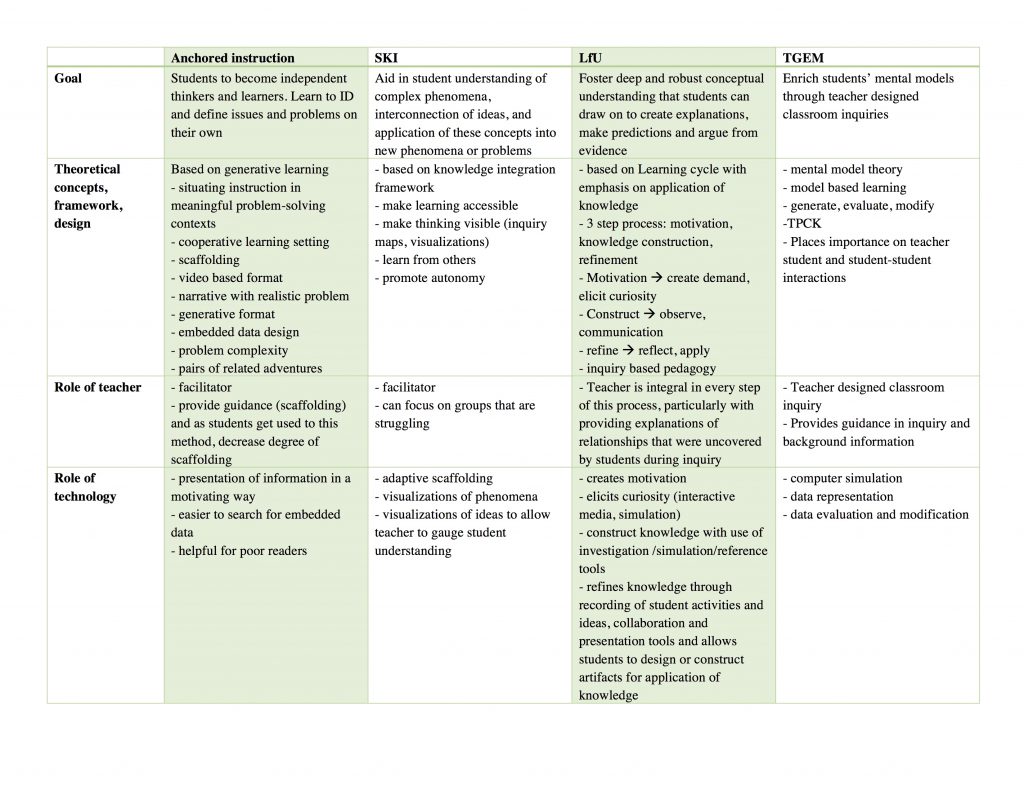https://blogs.ubc.ca/533james/
Category Archives: Uncategorized
T-GEM and Atomic Structure
From previous experience in teaching the chemistry portion of Science 9, it is apparent that Isotopes remain a difficult concept for many students to grasp. It is very common to see the same mistakes emerge on assignments and tests and remains a persistent issue for many students.
Using the concepts of TGEM (Khan, 2007), I have found generated an activity which works to teach atomic structure and isotopes using the Bill Nye Video and PhET simulation below.
PhET Simulation: Build-an-Atom

Khan, S. (2007). Model-based inquiries in chemistry. Science Education, 91(6), 877-905.
Actua: STEM Outreach Program
I came across this awesome Canadian company that organizes STEM outreach programs at your local university. Educators can organize for their classes to be engaged in these programs at the university or can arrange for the program to come to their school. This is run right across the country and would be a wonderful program to make use of. The website also includes various STEM activities for free! Check it out here.
Comparison & Synthesis
Sorry about the lateness, I’m out of town and have very spotty connections. But, here is my overall take of the TELEs.
|
Anchored Instruction and Jasper |
SKI and WISE |
LfU and MyWorld |
T-GEM and Chemland |
|
|
Learning Approach |
Use meaningful approach towards learning by helping students make meaningful connections to difficult concepts. Scaffold students through difficult concepts, with the help of media. Student-Centered |
Inquiry based learning on web. Builds knowledge through student- centred lessons. Interactive learning Self-paced |
Learning for use, putting purpose for the learning by identifying the use of the content. To motivate learning by identifying the use of the content in real world situations Student-Centered |
TPCK lessons that Generate, Engage, Motivate Lesson taught with the aid of simulators to digitally enhance learning. Student-Centered Interactive Learning |
Synthesis
From the different TELEs, we looked at, there were a few things that seems to have made up the basic recipe for successful TELEs. This list includes educators’ need to focus on creating lessons that are student-centered, have the option to be self-paced and allows for active learning through interactive interactions with the content through a technological component. Another key component noticed in the different frameworks, was also the critical thinking component in the approaches. The frameworks recognize the importance of students being intrinsically motivated through their own curiosity and skills, which fuels the learning process for each student.
Technologies can help educators guide students in the right direction while not having to physically cater each lesson for each student. That said, I believe that technology can only enhance a lesson so much, but can not completely replace the teacher’s existence, and technologies will only enhance a lesson if it’s chosen correctly.
A comparison of 4 TELEs
I decided to summarize the 4 TELEs in table format. This is what I came up with:

Below is a link to a PDF in case the above does not read well.
Module B synthesis
E-folio
The Flex Glove Exoskeleton
For my money, the best use of technology in the S/M classroom brings students closer to actively building solutions to real world problems.
Here’s an example of the role tech plays in my combined Science/Math 9 class: for a year end project, a group of students elected to make a robotic hand that can be controlled with a second “flex glove”. The use-case would be to do toxic chemical handling or other dangerous work remotely.

They researched their topic online with school laptops, and collaboratively made planning documents with Google Sheets and Docs. A bit of math for budgeting and sourcing their parts, and then it was time to break out the Arduino boards for a hardware development. Borrowing heavily from the online coding community of knowledge, they constructed the circuit and flex glove. They ran into some problems making the servo motors match the motion of the fingers—algebra to the rescue! Adding multipliers to their code they calibrated the fingers to make it work.
Then comes the 3D printing, and on and on. They are having a blast, learning a ton, and in true constructivist fashion, they have an artifact that they can share with their peers and the community at large. I feel that the connection they make between their abstract coding and the very concrete movement of a hand are a perfect fit for that age and stage. If there is a misconception about coding, degrees of rotation, or the like, it will be obvious in short order. This tackling of the gap between formal and informal learning was the subject of my last post and is my latest favourite thing.
I don’t believe this level of tech is viable for all schools. We happen to have external sponsorship for this project and without it, the state levels of funding would be inadequate. Scaling up would require a major investment in infrastructure, tech support, and pro-D. Given that state funding is 3/5 of what it was 15 years ago. How do we collectively make this a priority? What low-cost tech options exist in the meantime?
Floppy Disks
One of the earliest memories I have of using technology in the classroom was from my elementary school computer lab, where we were being explicitly taught how to save onto a floppy disk. I remember being given very specific instructions, of what to click and drag, where to place folders, etc. The process itself was lengthy and took a number of attempts (and a few fails or lost files) to get the hang of it. It was a necessary evil when it came to using technology, but if you followed the steps properly, you could save yourself a ton of time.
Now as an educator, I have found myself going back to this simple memory of the floppy disk. I was explicitly taught the steps of how to make the most of this piece of hardware. With students having technology at their fingertips nowadays, we take for granted their knowledge and comfort with tech, and we assume they know how to get the most out of it. I think that as we move forward in teaching students to use technology for their inquiry into the world, we mustn’t forget to explicitly teach them the critical steps of the how, when and why of technology so they become technology literate and not technology inundated.
Hello from Hamilton!
Hi Everyone,
My name is Kirsten and this is my 8th MET course. I am also in ETEC522 as well as 521 (wish me luck!). I took the last semester off so that my husband and I could backpack India, Nepal and Portugal for 2 months. Now we are back and I am ready to (try) and finish my MET!
I am an Elementary teacher with Hamilton-Wentworth District School Board in Hamilton, ON. In my ‘spare time’ I love to travel, read, explore the outdoors and spend time with our families in Orillia, ON. My husband and I also have just finished flipping our first house and are moving on to our second flip for a summer project in our hometown. That being said, it’ll be a very busy summer but I’m hoping to accomplish all of my goals so that come September I can focus solely on teaching again!
STEM is very big in my board and so I am looking forward to learning more about how to incorporate it into my classroom in a non-traditional way (Inquiry perhaps?).
I look forward to learning and working with all of you!
Kirsten
Hello From Barrie Ontario
Hi Everyone,
My name is Maureen! I live in Barrie, Ontario and have been teaching elementary grade students for close to 15 years. At this point in my career I would have thought that I am ready to coast my way to retirement. However, 5 years ago I began to think about technology and its potential to revolutionize education. One idea lead to another, and ended up with me applying to the MET program. That was then and now I am nearing the end of my journey with UBC. This is my second last course!!!!!
I have enjoyed all of my courses to date, but I am super curious about this one. My original degree was a bachelor of science in nursing, so I am interested in exploring any new learning that is related to science.
The city of Barrie is a great place to visit if you are thinking of traveling for the summer. It’s located in Central Ontario on the shore of Kempenfelt Bay and only an hour away from Toronto.
I look forward to getting to know everyone over the next little while:)